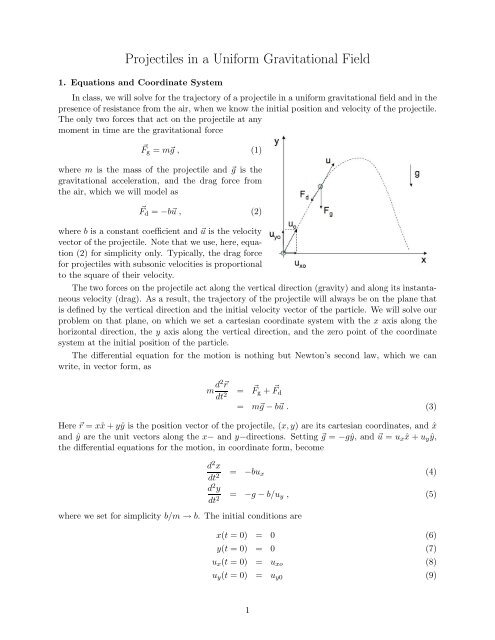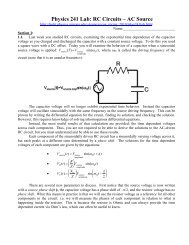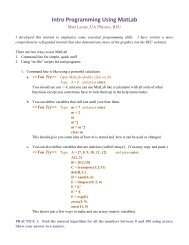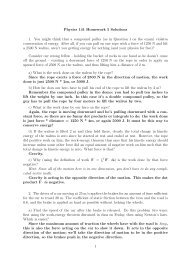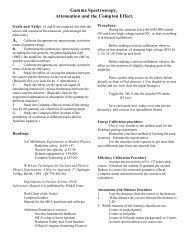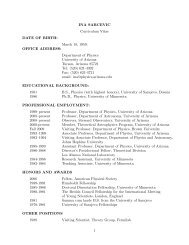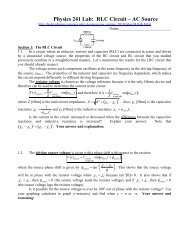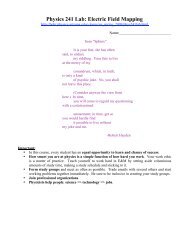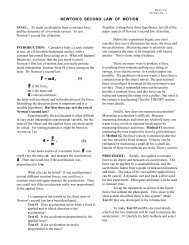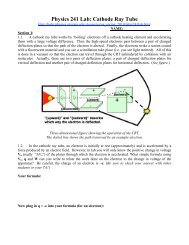Projectiles in a Uniform Gravitational Field
Projectiles in a Uniform Gravitational Field
Projectiles in a Uniform Gravitational Field
You also want an ePaper? Increase the reach of your titles
YUMPU automatically turns print PDFs into web optimized ePapers that Google loves.
<strong>Projectiles</strong> <strong>in</strong> a <strong>Uniform</strong> <strong>Gravitational</strong> <strong>Field</strong><br />
1. Equations and Coord<strong>in</strong>ate System<br />
In class, we will solve for the trajectory of a projectile <strong>in</strong> a uniform gravitational field and <strong>in</strong> the<br />
presence of resistance from the air, when we know the <strong>in</strong>itial position and velocity of the projectile.<br />
The only two forces that act on the projectile at any<br />
moment <strong>in</strong> time are the gravitational force<br />
⃗F g = m⃗g , (1)<br />
where m is the mass of the projectile and ⃗g is the<br />
gravitational acceleration, and the drag force from<br />
the air, which we will model as<br />
⃗F d = −b⃗u , (2)<br />
where b is a constant coefficient and ⃗u is the velocity<br />
vector of the projectile. Note that we use, here, equation<br />
(2) for simplicity only. Typically, the drag force<br />
for projectiles with subsonic velocities is proportional<br />
to the square of their velocity.<br />
The two forces on the projectile act along the vertical direction (gravity) and along its <strong>in</strong>stantaneous<br />
velocity (drag). As a result, the trajectory of the projectile will always be on the plane that<br />
is def<strong>in</strong>ed by the vertical direction and the <strong>in</strong>itial velocity vector of the particle. We will solve our<br />
problem on that plane, on which we set a cartesian coord<strong>in</strong>ate system with the x axis along the<br />
horizontal direction, the y axis along the vertical direction, and the zero po<strong>in</strong>t of the coord<strong>in</strong>ate<br />
system at the <strong>in</strong>itial position of the particle.<br />
The differential equation for the motion is noth<strong>in</strong>g but Newton’s second law, which we can<br />
write, <strong>in</strong> vector form, as<br />
m d2 ⃗r<br />
dt 2 = ⃗ F g + ⃗ F d<br />
= m⃗g − b⃗u . (3)<br />
Here ⃗r = xˆx + yŷ is the position vector of the projectile, (x, y) are its cartesian coord<strong>in</strong>ates, and ˆx<br />
and ŷ are the unit vectors along the x− and y−directions. Sett<strong>in</strong>g ⃗g = −gŷ, and ⃗u = u xˆx + u y ŷ,<br />
the differential equations for the motion, <strong>in</strong> coord<strong>in</strong>ate form, become<br />
where we set for simplicity b/m → b. The <strong>in</strong>itial conditions are<br />
d 2 x<br />
dt 2 = −bu x (4)<br />
d 2 y<br />
dt 2 = −g − b/u y , (5)<br />
x(t = 0) = 0 (6)<br />
y(t = 0) = 0 (7)<br />
u x (t = 0) = u xo (8)<br />
u y (t = 0) = u y0 (9)<br />
1
2. Convert<strong>in</strong>g Equations to Dimensionless Form<br />
In order to convert the equations to a dimensionless form, we will start by consider<strong>in</strong>g the<br />
units of the <strong>in</strong>dependent and dependent variables. In the problem we are study<strong>in</strong>g, there is one<br />
<strong>in</strong>dependent variable t of time units, i.e., [t]=[T], and two dependent variables, x, and y, of length<br />
unit [L], i.e., [x]=[L] and [y]=[L]. This means that we will need to come up with a unit of time, t 0 ,<br />
and a unit of length, l 0 .<br />
We will construct the natural units of the problem by look<strong>in</strong>g at (a) the <strong>in</strong>itial conditions, and<br />
(b) the parameters <strong>in</strong> the equation. In our problem, there are two <strong>in</strong>itial conditions <strong>in</strong> coord<strong>in</strong>ates<br />
of length units, i.e., [x 0 ]=[L], and [y 0 ]=[L], and two <strong>in</strong> velocities, of units [u x0 ]=[L]/[T] and<br />
[u y0 ]=[L]/[T]. F<strong>in</strong>aly, there are two parameters, b, and g, of units [b]=1/[T], and [g]=[L]/[T] 2 .<br />
The <strong>in</strong>itial conditions <strong>in</strong> coord<strong>in</strong>ates are (x 0 , y 0 ) = (0, 0) and, therefore, are not useful <strong>in</strong><br />
def<strong>in</strong><strong>in</strong>g the natural units of the problem. Us<strong>in</strong>g the other conditions and parameters, there are<br />
two possibilites of def<strong>in</strong><strong>in</strong>g a natural unit of time, s<strong>in</strong>ce<br />
[b −1 ]<br />
= [T ] (10)<br />
g<br />
= [T ] . (11)<br />
[ uy0<br />
(Note that, <strong>in</strong> this last equation, we could have used the <strong>in</strong>itial velocity <strong>in</strong> the x-direction, as well.)<br />
We will use our understand<strong>in</strong>g of the physics of the problem to choose among the two possibilities.<br />
The time def<strong>in</strong>ed by b −1 is the characteristic timescale for the air resistance to slow down the<br />
projectile. On the other hand, the time def<strong>in</strong>ed by u y0 /g is the characteristic timescale for gravity<br />
to accelerate or deccelerate the projectile. For most applications, gravity is the dom<strong>in</strong>ant force,<br />
and the latter timescale is the fastest. We, therefore, choose<br />
t 0 = u y0<br />
g<br />
(12)<br />
as our unit of time. We can the choose<br />
l 0 = u2 y0<br />
g . (13)<br />
as our unit of length. F<strong>in</strong>ally, hav<strong>in</strong>g chosen a unit of length and a unit of time, it is also natural<br />
to choose<br />
u 0 = u y (14)<br />
as the unit of velocity.<br />
We now set<br />
and convert the system of equations to<br />
t ′ = t/t 0 (15)<br />
x ′ = x/l 0 (16)<br />
y ′ = y/l 0 (17)<br />
u ′ x = u x /u 0 (18)<br />
u ′ y = u y /u 0 (19)<br />
d 2 x ′<br />
dt ′2 = −Au ′ x (20)<br />
d 2 y ′<br />
dt 2 = −1 − Au ′ y , (21)<br />
2
where we have def<strong>in</strong>ed a new dimensionless parameter<br />
The dimensionless <strong>in</strong>itial conditions are<br />
A = bv y<br />
g . (22)<br />
x ′ 0 = y′ 0 = 0 (23)<br />
u ′ x0 = u x0<br />
u y0<br />
≡ tan θ (24)<br />
u ′ y0 = 1 . (25)<br />
Clearly, the differential equation depends only on the parameter A and the boundary conditions<br />
only on the <strong>in</strong>itial angle with respect to the horizontal axis, θ.<br />
3. Set<strong>in</strong>g-up the Numerical Method<br />
In order to solve the above system of 2nd order ODEs with the Runge-Kutta method, we need<br />
to convert them to a system of 1st order ODEs. To this end we can use the def<strong>in</strong>ition of the<br />
velocities along the x− and y− axes and rewrite the system as<br />
with the same <strong>in</strong>itial conditions<br />
dx ′<br />
dt ′ = v x ′ (26)<br />
dv x<br />
′<br />
dt ′ = −Av x ′ (27)<br />
dy ′<br />
dt ′ = v y ′ (28)<br />
dv y<br />
′<br />
dt ′ = −1 − Av y ′ (29)<br />
x ′ 0 = y′ 0 = 0 (30)<br />
u ′ x0 = u x0<br />
u y0<br />
≡ tan θ (31)<br />
u ′ y0 = 1 . (32)<br />
3


